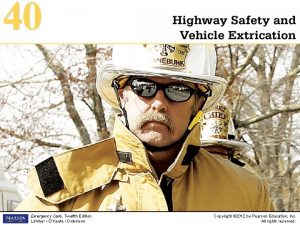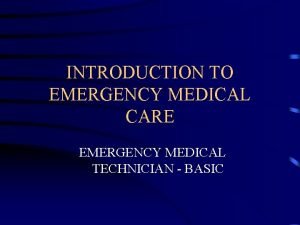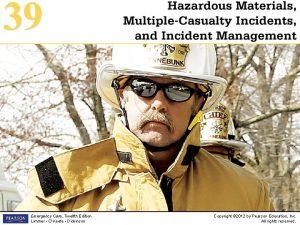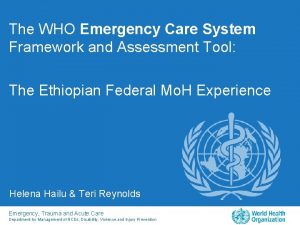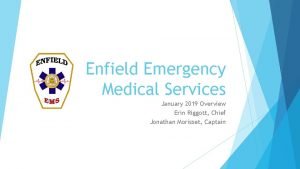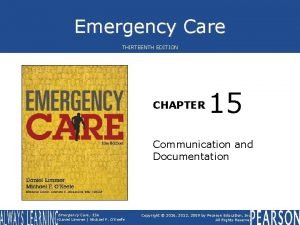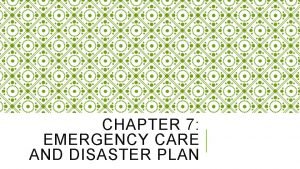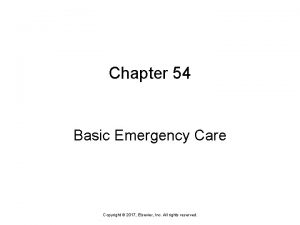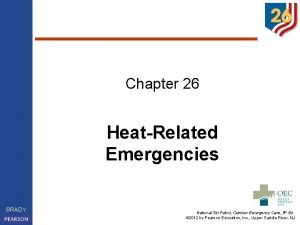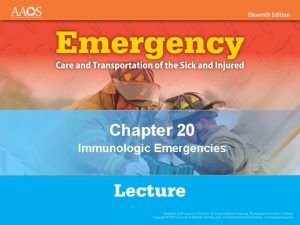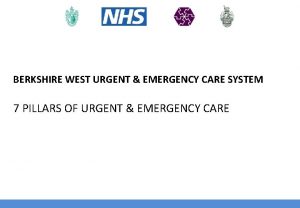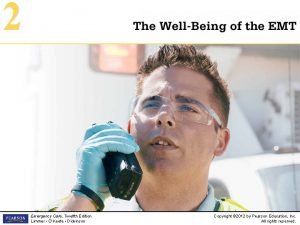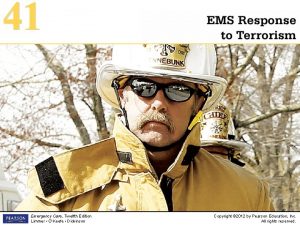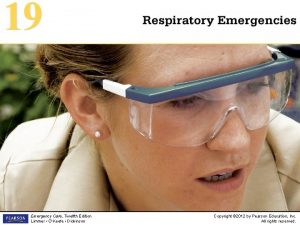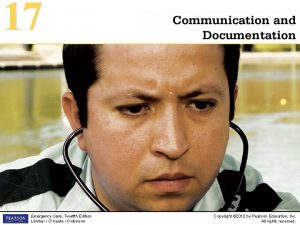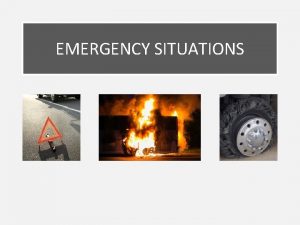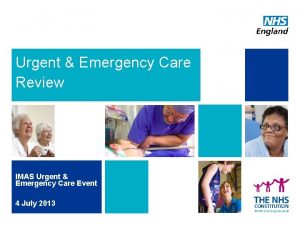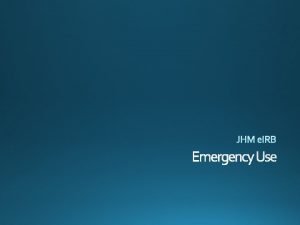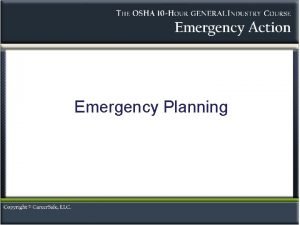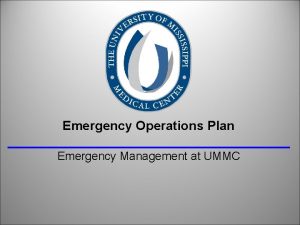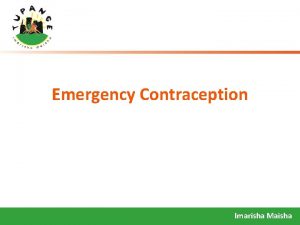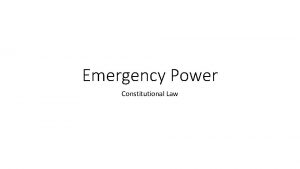Introduction to Emergency Care Lesson 1 Emergency Care
















- Slides: 16

Introduction to Emergency Care Lesson 1 – Emergency Care

Lesson 1 – Emergencies Emergency: sudden illness or injury that requires an immediate medical response Emergencies can happen at any time.

Lesson 1 – First Aid In many cases, emergency care may require some form of first aid. First Aid: help given to a sick or injured person until full medical treatment is available It is important that the general population and all health care workers know how to perform emergency care. Agencies such as the American Red Cross and the American Heart Association train people to perform these life-saving procedures.

Lesson 1 – Effective First Aid Providers Obtain proper first aid training This includes: ▫ Anyone in the medical field ▫ People in jobs that involve child care ▫ Park guides, camp counselors, life guards, etc.

Emergency Medical Services About 2 million people are hospitalized each year because of injuries Injuries result in nearly 142, 500 deaths each year. Unintentional injuries cause most childhood deaths. More than 70 million people in the US have cardiovascular disease which caused 1 million deaths each year. 500, 000 Americans have strokes each year, and 150, 000 Americans die each year from stroke. Your Role in helping make the EMS system work effectively: 1. Recognize that an emergency exist. 2. Decide to act. 3. Call the local emergency telephone number for help. 4. Provide care until help arrives.

Lesson 1 – Effective First Aid Providers (continued) Be alert for emergency situations Unusual sounds Unusual sights Unusual odors Unusual behaviors

Lesson 1 – Effective First Aid Providers (continued) Assess the situation before taking action The first aid provider should have a reason for every action that is taken. Treatment depends on multiple factors: Type of injury, the environment, witnesses, available first aid supplies, and how quickly medical help will arrive

Lesson 1 – Effective First Aid Providers (continued) Perform a safety check of the scene before taking action Some emergency scenes are unsafe to enter. Call for help immediately. Prioritize tasks and triage Triage is a way to prioritize treatment. It determines which patient or which injury is treated first. Life-threatening injuries should always be attended to first.

Lesson 1 – Effective First Aid Providers (continued) Remain calm in emergency situations and observe safety precautions If possible, get the patient’s consent If possible, wash their hands and put on gloves Make sure supplies are clean. If possible, explain the procedure Be careful when lifting heavy objects. Flush solutions that come into contact with eyes or skin Only perform care for which trained

Lesson 1 – Principles of Care Get professional care as soon as possible. Do not move a patient unless it is required for safety reasons. Keep the patient calm. Do not give unconscious or vomiting patients any food or fluids, unless the first aid procedure requires it. Regulate the patient’s temperature by adding blankets or removing layers of clothing. Administer first aid quickly and efficiently. Do not attempt to diagnose the patient or discuss the patient’s condition. Avoid further injury if possible.

Lesson 1 – Emergency Medical Services (EMS) provides expert care for serious emergencies. In many areas of the country, immediate help is available by dialing 911. When calling for help, be sure to give complete and accurate information. Description of the scene Exact location Actions performed Patients condition Your telephone number If you cannot call immediately, ask someone else to call for help.

Lesson 1 – Emergency Care Legal Issues The haste in which emergency care occurs often leaves the caregivers with little or no time to consider the legal consequences of their actions. Emergency care professionals, other health care workers, and anyone else who has first aid training should be aware of some basic legal issues related to emergency care.

Lesson 1 – The Good Samaritan Acts State that physicians and first responders are not required to acquire patient consent before performing life-saving procedures in the case of an emergency. To be protected by these Acts: ▫ Give care in good faith. ▫ Act within the scope of their training and knowledge. ▫ Use as much care as possible according to the circumstances. ▫ Do not bill the patient.

Lesson 1 – Scope of Practice Even a Good Samaritan Act cannot protect caregivers who perform procedures outside of their scope of practice. Emergency care providers should only perform tasks for which they have been trained.

Lesson 1 – Keeping Records Event report after each emergency This report includes: ▫ The patient’s name and address ▫ The date and time of emergency ▫ The location of emergency ▫ A description of the emergency and its cause ▫ A description of actions taken ▫ The names, addresses, and signatures of any witnesses ▫ The name and signature of the person preparing the report

First Aid Kit Items Video Triage Explanation Video Patient Rapid Assessment Video
 Introduction to emergency medical care
Introduction to emergency medical care Tdh ems
Tdh ems Medical
Medical Introduction to emergency medical care
Introduction to emergency medical care Primary secondary tertiary care nursing
Primary secondary tertiary care nursing Who emergency care system framework
Who emergency care system framework Prehospital emergency care 10th edition
Prehospital emergency care 10th edition Pre-hospital communication
Pre-hospital communication Pa wc bureau
Pa wc bureau Emergency care enfield
Emergency care enfield Emergency care 13th edition
Emergency care 13th edition Chapter 7 emergency care and disaster preparation
Chapter 7 emergency care and disaster preparation Chapter 54 basic emergency care
Chapter 54 basic emergency care Outdoor emergency care 6th edition
Outdoor emergency care 6th edition Care for a victim of an immunologic emergency
Care for a victim of an immunologic emergency Nhs 7 pillars
Nhs 7 pillars Emergency care first aid and disasters
Emergency care first aid and disasters
